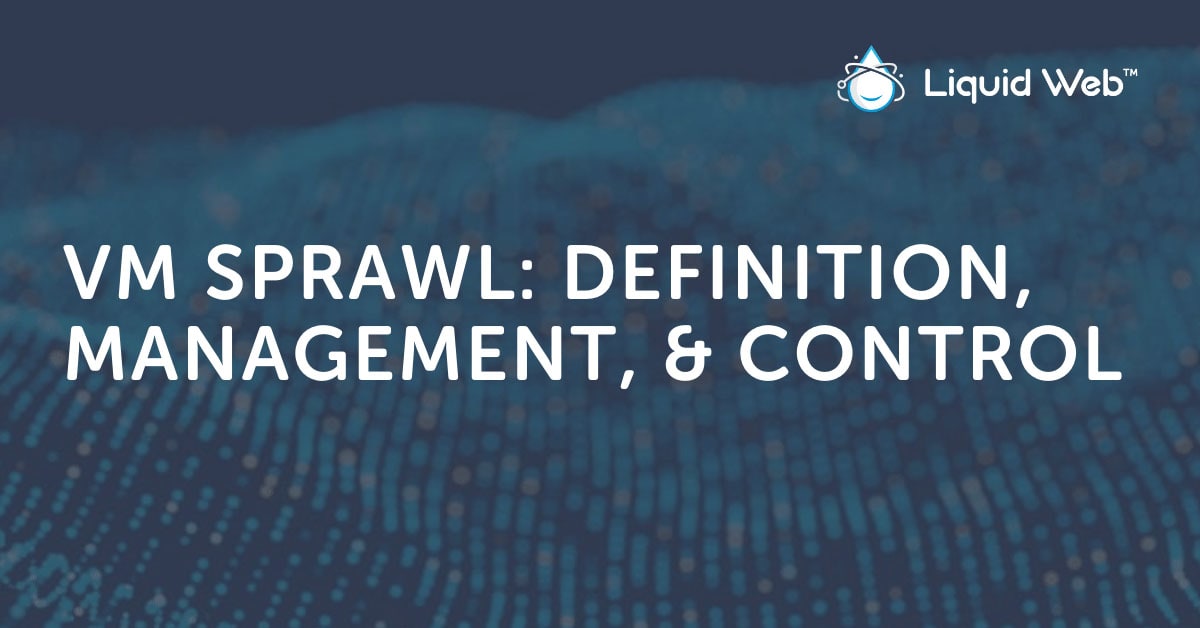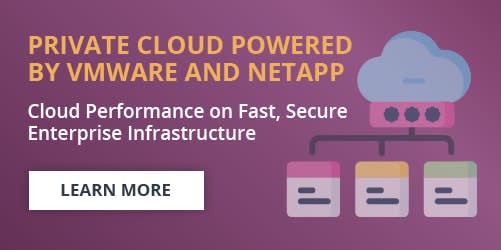
[ad_1]
Virtualization technology is one of the fastest-growing means of hosting today. With the ability to save server room space, create new servers on-demand, and management tools, businesses can set up their own virtual data centers quickly. However, with this ability to stand up new servers in rapid action, businesses can run into an issue called VM sprawl and system sprawl.
Let’s get started with the basics: What are VM sprawl and system sprawl?
VM Sprawl Definition
Simply put, VM sprawl (also known as a virtual sprawl, virtualization sprawl, virtual machine sprawl, or virtual server sprawl) is the collection of virtual machines on a network that administrators simply just cannot manage effectively by themselves without assistance.
System Sprawl Definition
System sprawl is similar: this occurs when systems expand out to a point that documentation and understanding are lost to system administrators. With so many parts and pieces to an environment, it is easy to lose sight of multiple servers and result in documentation being lost or never even established.

How Does VM Sprawl Happen?
Virtual machines are one of the most powerful tools a business can have to quickly create new systems on the fly. And adopting virtual environments can help you keep up with the speed of business. Virtual machines allow teams to allocate physical resources as they seem fit and deploy virtual machines quickly. It also allows businesses to cut out the need for massive server rooms for all their physical systems in favor of fewer but more powerful servers. Because of their speed and power, virtual environments are more attractive for customers with bigger needs but do not want to have to deal with so much physical infrastructure.
But while virtual environments are a great choice for many businesses, without set policies, procedures, or documentation, your infrastructure can quickly become bloated and out of control with VM sprawl and system sprawl. It is not uncommon that team members will create their own test environments for themselves, for clients, or for projects to fix issues. Also, frequent onboarding and departure of IT team members can cause more undocumented VMs than are accounted for.
Any one of these issues can lead to VM and system sprawl becoming out of control.
Business Impacts of VM Sprawl
We’ve talked about how VM sprawl and system sprawl can happen, but what are the costs that a business may run into? Let’s look at the risks, cost of resources, performance, and monitoring that teams need for effective VM sprawl management.
Risk and Security Issues
Today, every business faces risks with security no matter what infrastructure they use. Systems must be kept up to date, backed up, and kept protected.
If a system is suffering from VM sprawl, multiple issues arise:
- In the event of a zero-day attack or security issue, if a business does not have the tools or procedures to know which systems to update, virtual machines are left open to attack while leadership takes the time to make decisions.
- If an employee or team member who knows the VM infrastructure leaves, they may still have access to the system if their own access and virtual machines are not removed. This can lead to a security gap that would allow an outside force to cause havoc on the system.
- VMs need to be backed up like any other server. Having undocumented VMs can put a strain on the system as unneeded systems are backed up. Also, without proper management or documentation, critical virtual machines may be missed in a backup routine and result in a catastrophic data loss.
Cost of Resources
While virtual machines do offer a quick way to spin up new deployments, virtual machines do take up resources to run or exist.
If VM sprawl is present, businesses may run out of their allocated resources and space quickly. Although storage is cheaper today than in previous decades, businesses must keep in mind the cost of the main server that includes storage, memory, and CPU. Deploying virtual machines without proper management can eat up allocated physical resources very quickly leading to sprawl vulnerability and unnecessary IT spending for resources.
Along with physical resources, businesses must consider license costs. If a template is used that contains licenses (e.g., cPanel, Plesk, or Windows), license costs can add up. Businesses will need to keep an eye on what they are deploying.
Also, keep in mind that if a virtual machine is idled, it is still eating up valuable resources that might be better used elsewhere.
Performance and Monitoring
While virtual machines are deployed and built on powerful servers, there are limits to these systems. Without proper cloud monitoring and maintenance, VM sprawl can lead to a slow environment. Too many virtual machines running on a system can slow down the system during automated or scheduled tasks, leading to experience issues for visitors and customers visiting your applications and websites.
Also, businesses must consider the cost of overhead and man hours. A business administrator will need to manage all the resources and licenses, on top of managing backups, creating new virtual machines, and auditing what systems are no longer needed. Without proper monitoring, management tools, and procedures, this can drag out valuable billable time for administrators to maintain the system.
Finally, having a large VM sprawl makes it hard to forecast and plan for the future. Without auditing and monitoring, businesses will not have a clear image of how much resources are being used. This lack of visibility may stop teams from making accurate estimates on building new infrastructure for the future.

VM Sprawl Management Tactics
The good news is that VM and system sprawl are not hard to control. With proper tools and procedures, IT teams and businesses can get ahead of VM sprawl control with these VM management tactics.
Using a VM Management Tool
One of the easiest parts of using virtual machines is that there are options for an all-in-one VM management tool.
Liquid Web uses VMware vSphere with virtual machine services. It allows teams to architect, provision, deploy, monitor, and manage their environments in one. vSphere also makes configuration, monitoring, optimization, and security management much easier to handle in one location.
vSphere is a powerful tool that takes a lot of the work out of VM sprawl management for administrators and businesses.
But tools are not enough by themselves. A business must set up some of the following options to fully control the threat of VM sprawl.
Auditing, Archiving, and Cleanup
Cleaning isn’t only just for your home and office; it’s critical for your VM infrastructure as well.
Using a VM management tool will make the process of auditing, archiving, and cleanup much easier with these policies in place:
- Auditing: Businesses and IT teams should set up a repeating time frame where virtual machines are reviewed for their resource usage. This will help decide on what to do with VMs that are no longer needed, VMs from team members who are no longer with the company, and orphaned VMs.
- Archiving: During auditing, there may be situations where a team may choose to keep a virtual machine yet not use it. Archiving is a method to free up resources while keeping the data needed for later.
- Cleanup: Once auditing and archiving is finished, the process of clean up is simple as cleaning up and deleting unneeded VMs.
With our VMware systems, you can do this by backing up your virtual machine using Liquid Web’s Acronis Backups for easy backup management. Acronis allows users to take snapshots of their systems, and even restore individual files, folders, or full systems to make recovery easier.
Setting up Policies and Procedures
While having a VM management tool in place along with performing audits are two fundamental parts of keeping VM sprawl to a minimum, policies procedures are the final tool to keeping sprawl at bay.
When setting up policies and procedures, teams will want to consider answering the following questions. Answer these questions to start building policies around VM management and avoid VM sprawl:
- New VM: How often or who can deploy new virtual machines?
- Approval for VM: What qualifies as a viable use for creating a virtual machine? Who approves their creation?
- Process for VM Creation: How do teams input requests for resources or create virtual machines?
- VM Naming System: What naming system should virtual machines have?
- VM Access: Who can access the VM management tool and infrastructure?
- VM Auditing: How often do we audit our infrastructure for unneeded virtual machines?
- VM Archiving and Cleanup: How do we define what virtual machines are no longer needed? Who handles archiving and cleaning up? What is the process for teardowns?
- VM Resource Allocation: How much of the available resources can be allocated to virtual machines?
- VM Documentation: What documentation do we need? Do we want to map what projects use what virtual machines? What is on those virtual machines? Who (person, department, or client) is responsible for what virtual machines?
- Team Changes: What is the process for when team members leave or change teams?
Answering the above can help teams brainstorm and come up with the policies that work best for your business.
Not all policies will work for all businesses, but the basics are the same. Developing a naming system, deciding when to audit the environment, cleanup processes, and VM management access are all standard places to get started.
Find what works best for your teams while we help find you the best solutions for your needs.
Move to VMware Private Cloud Today
Managing VM sprawl is not hard when teams know the warning signs of VM and system sprawl. Armed with the information above, managing a virtual machine environment is easier now than ever before.
With Liquid Web’s VMware Private Cloud, businesses can begin building their own virtual environments while taking advantage of VMware’s features along with our robust infrastructure, fully managed systems, and world-class support teams.
[ad_2]
Source link







